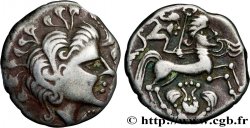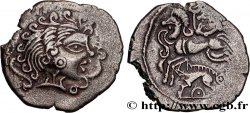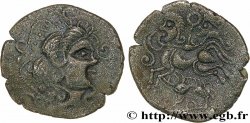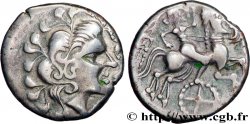v34_1278 - VENETI (Area of Vannes) Quart de statère d’or DT. 2134 au rameau en cimier
MONNAIES 34 (2008)
Starting price : 2 800.00 €
Estimate : 4 500.00 €
Realised price : 3 106.00 €
Number of bids : 3
Maximum bid : 4 125.00 €
Starting price : 2 800.00 €
Estimate : 4 500.00 €
Realised price : 3 106.00 €
Number of bids : 3
Maximum bid : 4 125.00 €
Type : Quart de statère d’or DT. 2134 au rameau en cimier
Date: IIe siècle avant J.-C.
Mint name / Town : Vannes (56)
Metal : gold
Diameter : 12,8 mm
Orientation dies : 1 h.
Weight : 1,85 g.
Rarity : R3
Coments on the condition:
Très belle petite monnaie, avec une frappe très légèrement bouchée au droit, mais avec un revers magnifiquement centré, par rapport à l’étroitesse du flan, et de conservation excellente
Catalogue references :
Obverse
Obverse legend : ANÉPIGRAPHE.
Obverse description : Tête à droite, les cheveux en grosses mèches ; de la tête partent quatre cordons perlés, terminés chacun par une petite tête, un rameau en guise de cimier au-dessus de la tête, entouré de deux cordons perlés.
Reverse
Reverse legend : ANÉPIGRAPHE.
Reverse description : Cheval androcéphale, bridé à droite ; au-dessus, l'aurige tient un lien ondulant relié à un étendard qui flotte devant la tête du cheval ; un personnage ailé sous le cheval.
Commentary
Cet exemplaire semble être issu des mêmes coins que le quart de la BN, n° 6894, repris pour illustrer le Nouvel Atlas. Les auteurs proposent une branche de gui (?) pour décrire le cimier. Cette rare monnaie appartient à ce groupe varié de quart sans statère unité connu. Au revers, la roue du char est hors flan, comme sur quasiment tous les quarts vénètes !.








 Report a mistake
Report a mistake Print the page
Print the page Share my selection
Share my selection Ask a question
Ask a question Consign / sell
Consign / sell
 Full data
Full data



